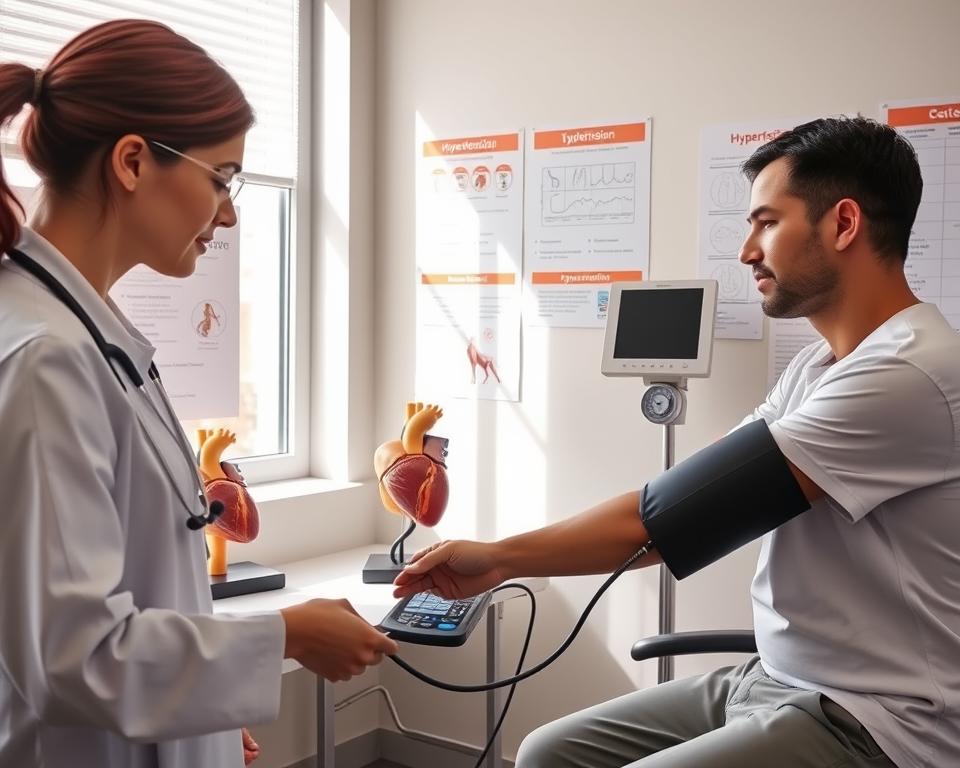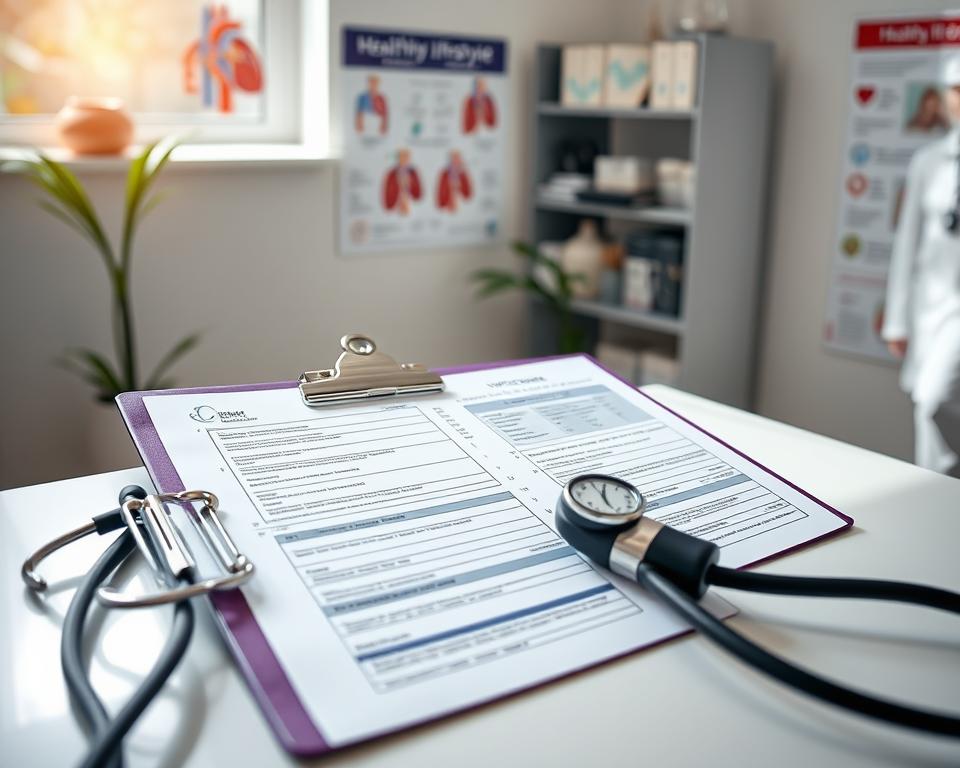In the realm of healthcare, the mastery of history taking for hypertension patients is paramount for enhancing patient outcomes. A thorough hypertension assessment is essential, allowing me to collect the requisite medical history of hypertension. This directly impacts my approach to managing hypertension in my patients. This section underscores the significance of effective history taking in comprehending and managing hypertension effectively. By refining this skill, I am better positioned to address my patients’ needs comprehensively, thereby delivering superior care that profoundly enhances their health.

Key Takeaways
- Effective history taking is foundational for hypertension management.
- A comprehensive medical history enables tailored treatment plans.
- Understanding patients’ backgrounds improves hypertension assessments.
- Building rapport enhances the effectiveness of history taking.
- Identifying risk factors is vital in managing hypertension.
The Importance of Effective History Taking
In the realm of hypertension management, the efficacy of history taking cannot be overstated. It is through the meticulous compilation of comprehensive medical histories that healthcare professionals significantly elevate patient care. A methodical approach facilitates the detection of potential complications, thereby guiding the formulation of bespoke treatment strategies.
Research underscores the significance of thorough assessments in achieving accurate diagnoses, which, in turn, influences the efficacy of treatment plans. The incorporation of a patient’s background, encompassing family history and prior medical conditions, empowers practitioners to devise interventions that are meticulously aligned with individual requirements. This targeted methodology not only augments treatment outcomes but also fortifies the bond between physician and patient.
Here’s a brief overview of the essential aspects of effective history taking:
| Aspect | Description | Impact on Patient Care |
|---|---|---|
| Patient Background | Collecting detailed information on medical history, lifestyle, and family history. | Identifies risk factors for hypertension and complications. |
| Symptom Identification | Recognizing current symptoms and their severity. | Enables timely interventions and reduces health risks. |
| Personalized Treatment | Incorporating individual patient data into care plans. | Enhances the likelihood of successful hypertension management. |
Understanding Hypertension: A Brief Overview
The comprehension of hypertension is paramount for those endeavoring to manage or alleviate high blood pressure effectively. This condition, often referred to as the “silent killer,” poses a significant threat to health without manifesting overt symptoms. It is divided into primary and secondary categories. Primary hypertension lacks a discernible cause, evolving gradually over years. Conversely, secondary hypertension stems from an underlying condition, such as kidney disease or hormonal imbalances.
Several pivotal risk factors contribute to the development of high blood pressure, including:
- Age
- Family history of hypertension
- Obesity
- Lack of physical activity
- Diet high in salt
- Excessive alcohol consumption
- Stress
Identifying these risk factors is crucial for early detection and management. Engaging patients in discussions about their lifestyle choices, family medical history, and any symptoms they may experience is essential. Such awareness can significantly enhance health outcomes.
History Taking of Hypertension
The meticulous compilation of a comprehensive medical history of hypertension is indispensable for accurate diagnosis and effective management. My focus encompasses several critical elements, each significantly influencing the patient’s treatment regimen. These components collectively offer a nuanced understanding of the patient’s overall health status.
Key Components of a Medical History
In the process of gathering a medical history of hypertension, I meticulously consider several pivotal aspects:
- Previous Blood Pressure Readings: Recording past measurements provides invaluable context for current hypertension symptoms.
- Medical Conditions: The presence of chronic diseases, such as diabetes or kidney issues, can significantly impact blood pressure levels.
- Medication History: A thorough understanding of current and past medications is essential to identify potential side effects.
- Lifestyle Factors: A patient’s dietary habits, physical activity levels, and stress management contribute to their overall condition.
Identifying Symptoms and Red Flags
Accurate identification of hypertension symptoms is paramount for timely intervention. I vigilantly monitor for:
- Headaches: Recurring or severe headaches serve as a critical warning sign.
- Chest Pain: Any chest discomfort necessitates immediate medical evaluation.
- Shortness of Breath: This symptom often indicates a severe underlying condition.
- Vision Changes: Sudden visual disturbances may be indicative of elevated blood pressure.
This methodical approach to history taking in hypertension facilitates a more detailed understanding, guiding treatment strategies tailored to the patient’s unique needs. Such meticulous attention to detail ensures a thorough medical history of hypertension, ultimately leading to enhanced health outcomes.
Initial Patient Interview for Hypertension
The efficacy of a patient interview for hypertension as a cornerstone in hypertension management cannot be overstated. The establishment of rapport is paramount, as it facilitates an environment where patients feel comfortable divulging their health information. This openness is critical, as it significantly enhances the quality of insights garnered during the interview.
Building Rapport and Trust
In the context of a patient interview for hypertension, the creation of a secure environment is indispensable. Trust between the patient and healthcare provider is a prerequisite for the disclosure of vital health information. Strategies to foster this trust include:
- Active listening: Demonstrating genuine interest in the patient’s concerns.
- Empathy: Acknowledging their feelings and experiences.
- Non-verbal communication: Maintaining eye contact and an open posture.
These methods not only build trust but also ensure the patient’s feelings of value and respect are upheld throughout the interview.
Asking Open-Ended Questions
Employing open-ended questions in patient interviews for hypertension can elicit detailed responses. Such inquiries prompt patients to elaborate on their symptoms, lifestyle, and preferences. Examples of such questions include:
- “Can you describe any symptoms you’ve been experiencing?”
- “What changes have you noticed in your daily routine related to your health?”
- “How do you feel about your current lifestyle and its impact on your blood pressure?”
Integrating these types of questions enriches the dialogue and fosters a deeper comprehension of the patient’s condition.
This comprehensive strategy positions the initial patient interview as a pivotal tool in hypertension management, ultimately contributing to enhanced patient outcomes.
Gathering Comprehensive Medical History
In the realm of hypertension management, the compilation of a detailed medical history emerges as a pivotal step. My examination encompasses not merely the patient’s blood pressure metrics but extends to encompass concurrent health conditions, prescribed medications, and lifestyle elements potentially influencing their well-being. This integrative strategy facilitates the identification of contributors to hypertension, thereby augmenting the efficacy of screening endeavors.
Within this framework, my attention is directed towards several critical domains:
- Past Medical History: This encompasses prior diagnoses of hypertension or allied conditions, such as cardiovascular disease, diabetes, or renal disorders.
- Medications: A meticulous cataloging of all medications, encompassing both prescription and over-the-counter substances, reveals potential drug interactions or side effects impacting blood pressure.
- Family History: The comprehension of familial health trends allows for the assessment of genetic predispositions to hypertension.
- Lifestyle Choices: Insights into dietary habits, physical activity levels, and behaviors such as smoking or alcohol consumption are instrumental in managing blood pressure.
Accurate documentation during these interactions is paramount. It serves not only to support the current assessment but also to facilitate targeted follow-up interventions. By synthesizing data from the comprehensive medical history with ongoing screening efforts, I can devise a hypertension management strategy tailored to individual patient needs, thereby optimizing health outcomes.
Hypertension Assessment Techniques
In the realm of hypertension evaluation, diverse assessment techniques are pivotal for comprehensive understanding and management. My analysis frequently juxtaposes home monitoring against clinical measurements, highlighting their unique benefits that significantly impact patient outcomes.
Home Monitoring vs. Clinical Measurements
Home blood pressure monitoring empowers patients to track their readings outside the clinical environment. This approach facilitates a detailed understanding of a patient’s blood pressure patterns over extended periods. Conversely, clinical measurements, conducted during routine check-ups, offer a standardized framework for hypertension assessment.
Both methodologies yield invaluable insights, yet home monitoring captures blood pressure fluctuations that might elude detection during a single clinical visit. Continuous tracking is indispensable for precise hypertension assessment.
Evaluating Blood Pressure Readings
The evaluation of blood pressure readings is critical for diagnosing and managing hypertension. Clinical measurements, typically performed with a sphygmomanometer, establish an initial baseline for blood pressure levels. These standardized readings can be augmented by data from home monitoring devices, which allow patients to record measurements at different times and under various conditions.
This integration of methods enhances the assessment process, enabling healthcare providers to make informed decisions tailored to individual patient needs. I advocate for patients to participate in both home monitoring and clinic visits for optimal blood pressure monitoring.

Identifying Hypertension Risk Factors
Grasping the hypertension risk factors is paramount for those endeavoring to manage or avert high blood pressure. Risk factors can be delineated into modifiable and non-modifiable categories. Identifying these elements is essential for crafting efficacious prevention tactics.
- Non-modifiable Risk Factors:
- Age: The risk escalates with advancing years.
- Family History: Genetic predisposition significantly influences hypertension risk.
- Modifiable Risk Factors:
- Lifestyle Choices: Dietary habits, physical activity, and weight control are pivotal.
- Substance Use: Smoking and alcohol excess significantly elevate risk.
- Stress Levels: Persistent stress can contribute to elevated blood pressure.
Research underscores the efficacy of lifestyle modifications in managing risk factors, thereby facilitating effective high blood pressure evaluation. Minor adjustments, such as embracing a balanced diet and enhancing physical activity, frequently yield substantial improvements in blood pressure readings.
Discussing Lifestyle Factors with Patients
In the realm of hypertension management, the exploration of lifestyle factors with patients can be profoundly transformative. These elements significantly sway blood pressure levels, rendering them indispensable within any therapeutic regimen. Through dialogue centered on diet considerations and the promotion of physical activity for hypertension, patients’ health trajectories can be markedly enhanced.
Diet and Nutritional Considerations
The significance of a balanced diet in the control of hypertension cannot be overstated. The DASH diet, with its emphasis on whole foods such as fruits, vegetables, whole grains, lean proteins, and low-fat dairy, emerges as a cornerstone recommendation. This dietary approach not only aids in blood pressure management but also fosters comprehensive cardiovascular well-being.
- Incorporate more potassium-rich foods like bananas, oranges, and sweet potatoes.
- Limit sodium intake by avoiding processed foods, which are often high in salt.
- Choose heart-healthy fats found in olive oil, avocados, and nuts.
Physical Activity and Exercise Habits
Engagement in regular physical activity is a critical component of hypertension management. I advocate for patients to engage in at least 150 minutes of moderate-intensity aerobic exercise weekly. Activities such as brisk walking, cycling, or swimming can significantly impact blood pressure levels.
- Start with small, achievable goals to build consistency.
- Incorporate strength training exercises at least twice a week.
- Consider activities like yoga or tai chi for added stress relief.
Through the cultivation of open dialogue regarding these lifestyle elements, patients are empowered to proactively manage their hypertension.

| Lifestyle Factor | Benefits |
|---|---|
| Healthy Diet | Reduces blood pressure and promotes heart health |
| Regular Exercise | Improves cardiovascular fitness and lowers stress |
| Sufficient Sleep | Regulates hormones and decreases blood pressure levels |
| Stress Management | Helps maintain lower blood pressure through relaxation techniques |
Understanding Family History and Genetics
In my professional practice, the exploration of a patient’s family history of hypertension is paramount. Such information offers invaluable insights into the genetic factors potentially influencing an individual’s risk for developing high blood pressure. Research substantiates that hypertension can exhibit familial patterns, underscoring the role of genetic predisposition in this condition.
During the evaluation of a patient’s family history, I seek patterns indicative of inherited traits. For example, if hypertension is prevalent among family members, it may suggest a genetic basis. I gather data not only on hypertension but also on other related conditions. This broader perspective aids in illuminating familial health trends, thereby informing treatment strategies.
By grasping the genetic underpinnings, I can personalize interventions based on a patient’s unique risk profile. Combining family history with individual lifestyle factors enables me to devise a holistic management plan for hypertension. For instance, a patient with a significant family history of hypertension may benefit from earlier or more frequent screenings, alongside lifestyle adjustments to reduce their risk.
| Familial Hypertension Patterns | Genetic Influence | Potential Management Strategies |
|---|---|---|
| Multiple relatives affected | High likelihood of genetic factors | Early monitoring, lifestyle changes |
| Single relative affected | Possible but less pronounced genetic influence | Regular check-ups, education on healthy habits |
| No family history | Lower genetic predisposition | Preventive measures through lifestyle modification |
Assessing Comorbid Conditions
In the realm of hypertension management, the exploration of comorbid conditions emerges as a paramount concern. The intricate interplay between these conditions necessitates a bespoke approach to treatment, thereby optimizing patient outcomes. The synergy between diabetes and hypertension, frequently observed in clinical settings, underscores the complexity of their combined impact on patient health.
Diabetes and its Relation to Hypertension
The nexus between diabetes and hypertension is extensively documented. Both afflictions are linked by common cardiovascular risk factors such as obesity and elevated cholesterol levels. My clinical experience reveals a heightened propensity for hypertensive development among diabetic individuals. This dual diagnosis complicates therapeutic strategies, mandating rigorous lifestyle adjustments and personalized pharmacological interventions.
Other Cardiovascular Risk Factors
Beyond diabetes, a plethora of cardiovascular risk factors are pivotal in the assessment of hypertensive patients. These encompass:
- Smoking
- High cholesterol levels
- Age and family history of heart disease
- Lack of physical activity
- Chronic kidney disease
Each of these elements can modulate the intensity of hypertension and the efficacy of therapeutic interventions. Acknowledging and addressing these comorbidities not only facilitates blood pressure control but also bolsters overall health management.

Hypertension Diagnosis Process
The diagnosis of hypertension necessitates a meticulous amalgamation of patient history and clinical assessment methodologies. In my professional endeavors, I emphasize the compilation of exhaustive patient data, which forms the cornerstone for precise hypertension diagnosis. This process commences with the meticulous documentation of patient histories, encompassing not only blood pressure readings but also lifestyle factors, medical antecedents, and symptoms.
Guidelines from the American College of Cardiology and the American Heart Association underscore the centrality of consistent blood pressure measurements in diagnosing hypertension. My clinical assessments employ both manual and automated devices to guarantee accurate readings. It is imperative to obtain measurements across various times of the day to affirm a diagnosis. This approach underscores the significance of averaging readings over relying on a solitary measurement.
Understanding the criteria for hypertension classification is another critical component. Blood pressure is categorized into elevated, stage 1 hypertension, or stage 2 hypertension based on predefined numerical thresholds. I frequently consult the following table for a comprehensive understanding:
| Category | Systolic (mm Hg) | Diastolic (mm Hg) |
|---|---|---|
| Normal | Less than 120 | And less than 80 |
| Elevated | 120-129 | And less than 80 |
| Stage 1 Hypertension | 130-139 | Or 80-89 |
| Stage 2 Hypertension | 140 or higher | Or 90 or higher |
This categorization facilitates the determination of subsequent management and treatment strategies. By integrating clinical assessment techniques, I vigilantly monitor for secondary hypertension indicators, which may require additional diagnostic evaluations. Through this structured diagnostic framework, I strive to enhance patient outcomes continually.
Compiling Patient Information for Treatment Plans
In the realm of hypertension treatment, the compilation of patient data is paramount. The aggregation of a patient’s medical history, lifestyle, and overall health enables the formulation of tailored management strategies. This meticulous process ensures that each patient’s unique needs are addressed, fostering a personalized approach to their care.
The foundation of these strategies lies in the integration of clinical assessments, including blood pressure readings and prior medical evaluations. Furthermore, understanding a patient’s dietary habits, exercise routines, and stress levels is crucial for optimizing treatment outcomes. This necessitates a collaborative approach, where patient engagement in the decision-making process is paramount. Such involvement not only enhances adherence to treatment plans but also empowers patients to take an active role in their health.
To exemplify the effectiveness of compiling patient information, I adhere to the following protocols:
- Thoroughly document the patient’s medical history, noting any previous diagnoses and treatments.
- Assess current medications and their impact on hypertension management.
- Evaluate lifestyle factors, including nutrition and physical activity.
- Encourage open communication, fostering an environment where patients feel comfortable sharing their health concerns.

Utilizing Technology in History Taking
In my examination of technology’s impact on history taking, it is evident that healthcare advancements significantly augment our comprehension and management of hypertension. The advent of digital health tools has revolutionized my interactions with patients, facilitating the collection of data and enabling more thorough assessments.
The introduction of electronic health records (EHRs) marks a significant transformation. EHRs simplify the documentation process, creating a centralized repository for patient information accessible at will. This facilitates seamless continuity of care, as healthcare professionals can promptly access a patient’s history when necessary.
Telemedicine represents another groundbreaking advancement in history taking technology. It enables remote consultations, allowing patients to share their medical histories from the comfort of their homes. This method enhances patient engagement, as individuals may feel more at ease discussing their health concerns in a familiar setting.
Mobile health applications further contribute to this evolution. These digital tools empower patients to monitor their blood pressure regularly, track symptoms, and submit their readings for review. By integrating these applications into my practice, I observe a marked increase in patient compliance and a more proactive approach to managing hypertension.
Extensive research supports the integration of technology into history taking, demonstrating its positive impact on hypertension care. The collaboration between healthcare providers and patients facilitated by digital health tools ensures that vital information is captured and analyzed. This synergy enhances the treatment experience, aligning with the dynamic landscape of modern healthcare.
Conclusion
The conclusion on hypertension history taking underscores the critical importance of a holistic approach in managing this widespread condition. This article has elucidated the pivotal elements necessary for effective history taking, encompassing an understanding of patient lifestyle factors, the assessment of risk factors, and the utilization of technology to augment accuracy and reliability. By synthesizing these components, we can attain a more comprehensive understanding of each patient’s distinct circumstances.
Reflecting on this discourse, it is evident that a detailed history is far more than a mundane procedure; it serves as a foundational element in the comprehensive management of hypertension. The enhancement of our educational endeavors and the refinement of history-taking methodologies will not only deepen our comprehension but also contribute to improved patient outcomes. The trajectory of hypertension management hinges on our capacity to evolve these techniques and tailor them to the dynamic needs of our patients.
Each encounter with patients represents a unique opportunity for growth and learning, facilitating the development of more effective, patient-focused hypertension management strategies. As we continue to strive for excellence in hypertension care, I anticipate significant advancements in our practices.
FAQ
What is the importance of history taking in hypertension management?
Mastering the art of history taking is paramount in the realm of hypertension management. It enables healthcare professionals to amass a comprehensive repository of patient data, encompassing their medical history, symptoms, and risk factors. This thorough comprehension facilitates the formulation of more efficacious management strategies, thereby enhancing treatment outcomes.
How can I identify hypertension risk factors during a patient interview?
In the context of patient interviews, my focus is on both modifiable and non-modifiable risk factors. I delve into age, lifestyle choices, and family history, employing open-ended questions to elicit detailed information regarding patients’ habits and familial backgrounds. These factors significantly influence blood pressure levels.
What symptoms should I look for in hypertension patients?
Hypertension often manifests with subtle symptoms, colloquially referred to as the “silent killer.” During the history taking process, I scrutinize symptoms such as headaches, dizziness, shortness of breath, and blurred vision. Additionally, I investigate any concurrent medical conditions that might be present.
How can technology assist in gathering patient information for hypertension history taking?
Technology emerges as a pivotal tool in enhancing history taking, leveraging electronic health records, telemedicine, and mobile health apps. These innovations facilitate enhanced patient engagement, data collection, and management of hypertension, thereby contributing to superior outcomes.
What lifestyle factors should I discuss with patients concerning hypertension?
I underscore the significance of diet, physical activity, and other lifestyle elements in managing hypertension. Discussing dietary recommendations, such as the DASH diet, and promoting regular exercise are crucial for my patients’ overall well-being.
How do comorbid conditions like diabetes affect hypertension management?
Comorbid conditions, notably diabetes, complicate hypertension management. I meticulously assess these interrelations to devise comprehensive treatment plans that address both conditions. Successful management necessitates a multifaceted approach, tailored to the patient’s unique needs.
What are the primary methods for assessing blood pressure?
Blood pressure assessment encompasses both clinical measurements and home monitoring. I advocate for the benefits of home monitoring, as it provides a more accurate reflection of blood pressure levels in a familiar setting. This yields invaluable data for treatment evaluations.
How does family history impact hypertension diagnosis?
Understanding a patient’s family history is critical for hypertension diagnosis. A familial pattern of high blood pressure often signifies a genetic predisposition. This insight guides my assessment and treatment strategies, enabling the development of the most effective management plan.
